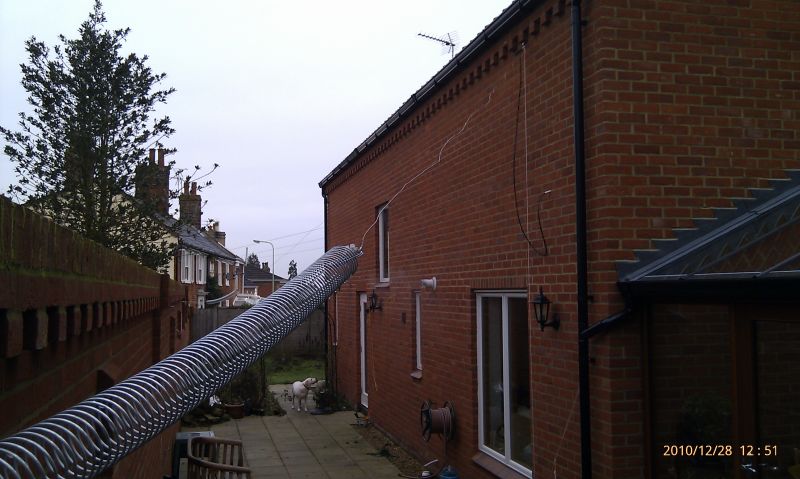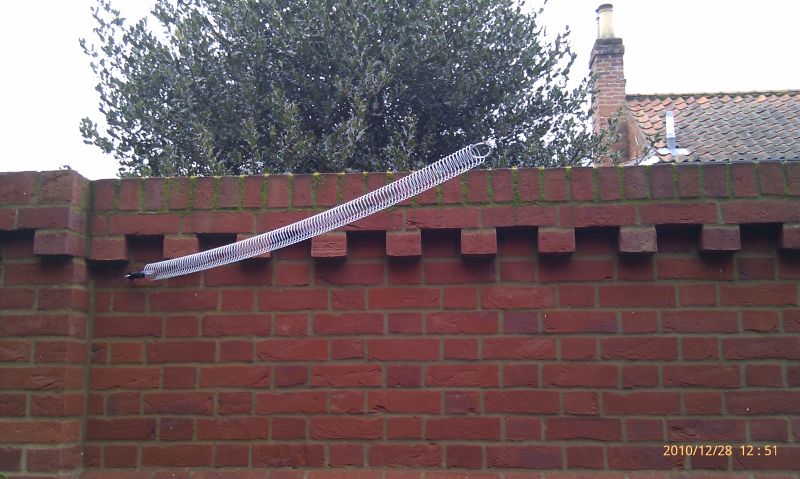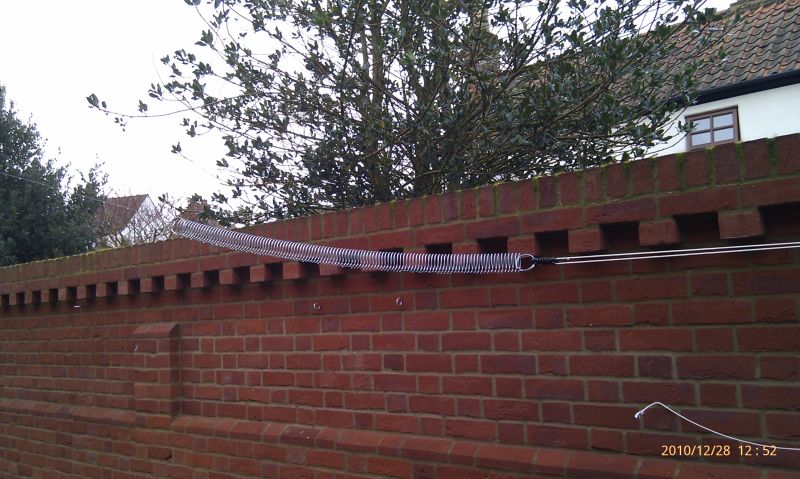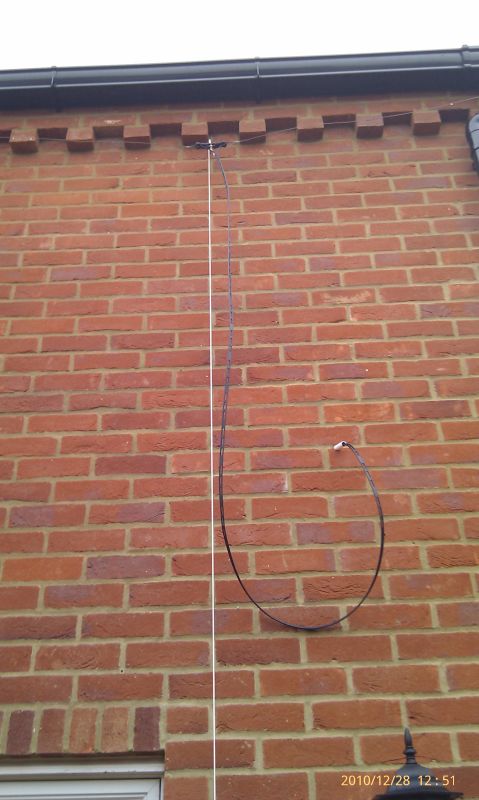Photos A 40 metre dipole reduced to 3 metres.
This is an 80 metre dipole that fits in a small space. An ATU is needed and using the ATU, the antenna works on other bands too. It is ideal for portable use because of its small size.
This antenna idea came from various websites where the metal slinky toy had been pressed into use for an antenna. The slinky suffers from corrosion and is really only suitable for indoor use.
What was needed was an outdoor, heavy duty, corrosion resistant slinky. The electric fence gate spring fitted the bill. Visit your farming supplies store and buy two. Get ones that stretch up to 5 metres. They are available on-line too. Stainless steel springs would be good if you can find them.
Next, discard everything apart from the springs.
Now build your dipole like this.
The wire should be as long as your available space permits. I used about 5 metres on each leg.
The spring need not be stretched far but make sure the turns are not touching, even in strong wind.
My gate spring could not be soldered so the wires were attached with screw down chocolate blocks, well greased with silicone to slow corrosion at the contact points. I have now discovered special flux for stainless steel. My next project will be a soldered construction as the chocolate blocks are not really satisfactory.
My antenna was mounted as an inverted vee with the ends about 2.5 metres above ground.
The centre feed was about 6 metres above the ground.
This configuration is likely to have a high radiation angle, good for more local contacts.
For a lower radiation angle, mount it vertically or as near to vertical as possible. An inverted L might also work but both these confugurations might have more unbalanced feeder currents.
Using an antenna tuning unit suitable for balanced line, this could be brought to 1:1 SWR on 80, 40 and 20 metres but not 160 metres.
Using four springs might work for top band.
Fourspring Durch Technik!
Within minutes, I had QSOs from the UK to Italy and the Channel Islands so the antenna works.
Obviously a full size dipole will work better but this is a nice idea for a site with limited space.
This whole exercise was done on guesswork. If I ever have time, I might use an antenna analyser
to see if the design could be improved. Proper resonance on 80 metres would be a good start.
To make the antenna work better, experiment with the amount of spring stretch and the length of the wire sections.
I plan to raise the entire antenna using three poles, two at the ends and one in the centre.
This should reduce losses, raise the feed impedance and improve the efficiency of the antenna.
There is space for a longer antenna. This one was cut to length using all my available wire.




If you make an antenna smaller, it will be less efficient so if you have space, go for the full sized item.
This is built from three 5 metre gate springs chocolate blocked together into one long spring. This is threaded onto a 3 metre white PVC water drain pipe. The chocolate block joints are not a good permanent solution and soldering would be better but this is not at all easy with stainless steel. Once I finalise this design, I might rebuild it with copper wire if I can find a neat way to space the coil turns.
Tuning the antenna really requires an antenna analyser and the antenna should be positioned exactly as it will be once tuned up. Tuning with a 7 MHz transmitter and SWR meter might also work.
The aim is to get a 50 Ohm feed with a 1:1 balun or a 200 Ohm feed with a 4:1 balun by adjusting the gamma match.
It was possible to tune the antenna from about 6.7 to 7.5 MHz by stretching or compressing the spring coils near the feed point. There was no need to cut off any spring coils. This was pure luck and really easy. Once tuned, the coils can be pegged or tied into position. It might even be possible to tune the antenna at its working height by pulling on strategically tied strings.
Use co-ax to centre feed the dipole with an unbalanced gamma match without a balun or with a compact ferrite rod balun that fits insite the tube.
Route the co-ax down the inside of the water pipe.
The co-ax braid is connected to the centre of the dipole.
The centre conductor is connected to the spring at the 50 Ohm feedpoint position.
Find this with an antenna analyser or by trial and error.
This method might de-tune the antenna so badly that it can't be used and I have not yet tried it.
If it worked, you'd have a half wave vertical for 40 metres with a radiation angle lower than the horizontal version.
The whole antenna could be enclosed and weather-proofed in a larger diameter plastic pipe.
For a stealth antenna, disguise it as a roof water down pipe. It might be possible to redesign it to carry water in the innermost pipe. That would be fine.
This antenna might have lower losses than commercial multiband verticals of a similar size so it's worth a try and no radials are needed.
It should be a lot less fussy about tuning than a small loop antenna. However a small loop antenna might have lower resistive energy losses.